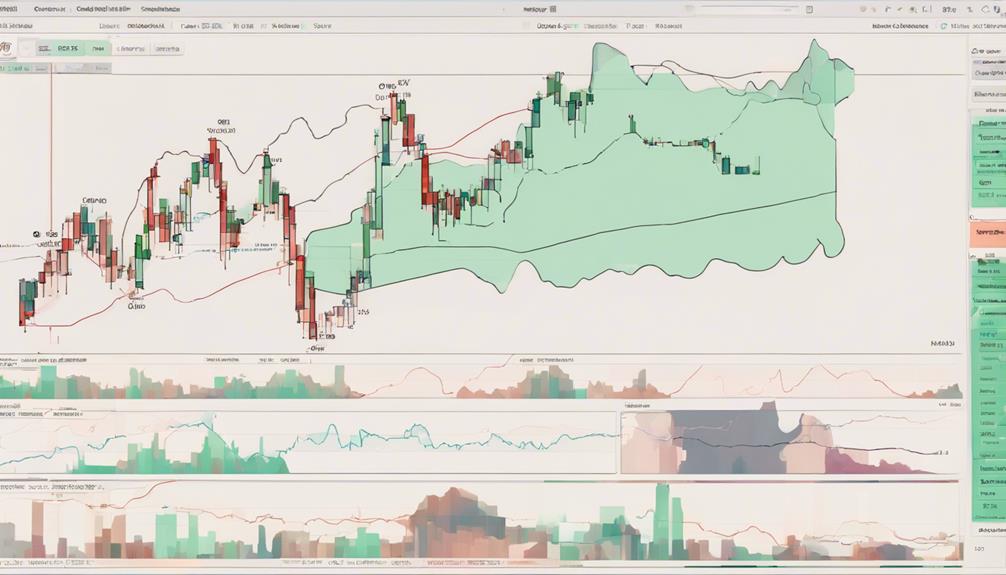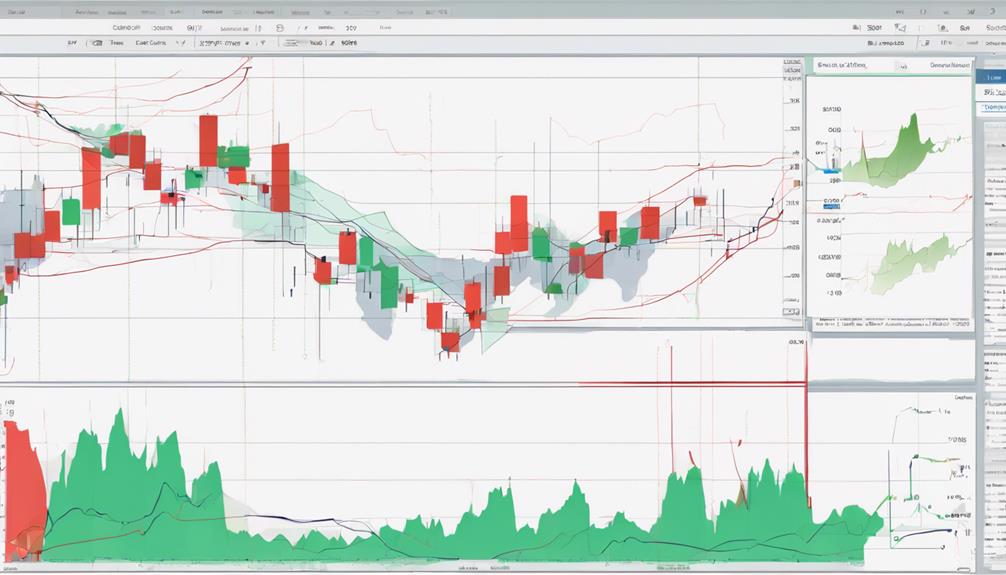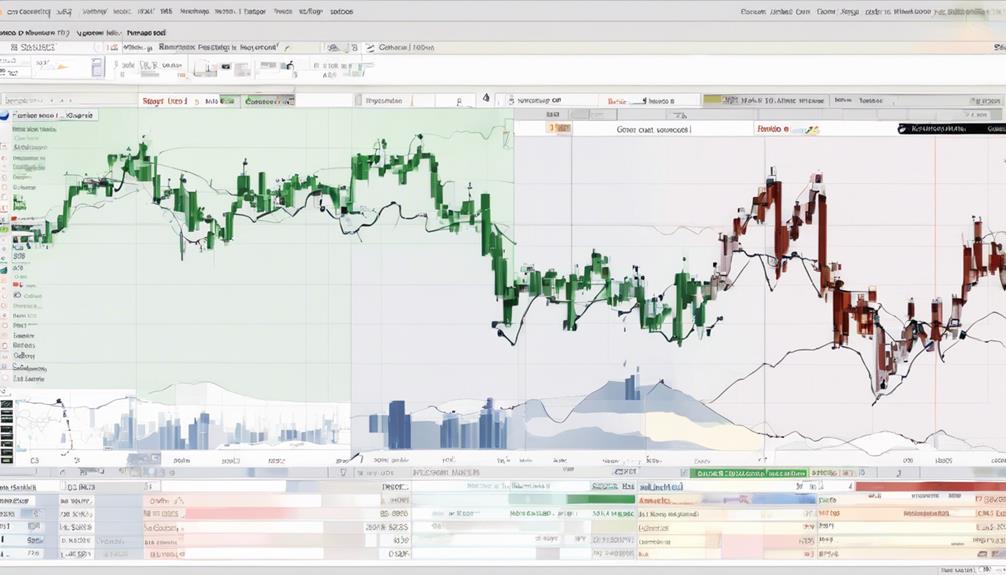You may have heard of the Ichimoku Cloud and thought it seems complex, but fear not, as we're here to simplify it for you.
Want to uncover how this indicator can help you identify potential trading opportunities, set stop-loss levels, and determine market trends more efficiently?
Stay tuned as we break down the key components and practical applications of the Ichimoku Cloud in a straightforward manner, allowing you to grasp its power in enhancing your trading decisions.
Understanding the Ichimoku Cloud Components
The Ichimoku Cloud indicator comprises five essential components that play a crucial role in technical analysis.
These components include Tenkan Sen, calculated over the past nine periods, and Kijun Sen, calculated over the past 26 periods.
The Senkou Span A and Senkou Span B lines form the Kumo cloud, reflecting current and historical price action.
Traders can gauge trend strength by analyzing the thickness of the cloud, aiding in making informed trading decisions.
Additionally, the Chikou Span, which compares current price to past price, serves as a tool for confirmation in trading strategies.
Understanding these technical aspects of the Ichimoku Cloud indicator is vital for interpreting price action effectively and enhancing the precision of trading decisions.
Interpreting the Ichimoku Cloud Signals

Interpreting Ichimoku Cloud Signals involves analyzing various components to identify trend directions and potential momentum shifts in the market.
When the TenkanSen rises above the KijunSen, it signals a positive trend. Additionally, having both the TenkanSen and KijunSen above the Cloud indicates a positive trend direction.
The Ichimoku Cloud provides crucial support and resistance levels, aiding in assessing momentum. Crossovers between the TenkanSen and KijunSen offer signals for changes in momentum.
The Chikou Span reflects market sentiment, which is valuable for market analysis. By understanding these elements and their interactions, you can interpret Ichimoku Cloud Signals effectively to gauge market sentiment, identify trend directions, and anticipate potential price movements.
Utilizing Ichimoku Cloud in Trading Strategies

Utilize Ichimoku Cloud effectively by incorporating moving average crossovers using TenkanSen and KijunSen, and analyzing cloud thickness to enhance your trading strategies. By understanding cloud thickness, traders can assess trend strength and identify potential entry/exit points with more precision.
The Chikou Span serves to confirm trading signals generated by the Ichimoku Cloud, adding an additional layer of validation to your decisions. For stronger trade confirmation, consider combining Ichimoku Cloud with other indicators.
Adjusting parameters based on current market conditions is crucial to optimize the effectiveness of the Ichimoku Cloud in your trading strategies. Stay proactive in monitoring and adapting to market changes to make the most of this versatile indicator.
Comparing Ichimoku Cloud With Other Indicators

Comparing Ichimoku Cloud with other indicators provides traders with a distinct perspective on market trends and potential trading opportunities. Unlike traditional moving averages, Ichimoku Cloud uses averages differently, incorporating highs and lows divided by two.
The TenkanSen and KijunSen lines within the Ichimoku Cloud act as moving average crossovers, offering unique information compared to standard moving averages. While both Ichimoku Cloud and traditional moving averages provide valuable insights, they do so in different ways.
To enhance risk-adjusted returns, traders should validate Ichimoku Cloud signals with other technical analysis tools. By combining the strengths of various indicators, traders can gain a comprehensive understanding of market dynamics and make well-informed trading decisions.
Overcoming Challenges When Using Ichimoku Cloud

To effectively navigate the challenges associated with using the Ichimoku Cloud indicator in trading, traders must prioritize a comprehensive understanding of all five components. When facing obstacles, consider the following strategies:
- Validate signals with other technical analysis tools to enhance accuracy.
- Interpret the cloud with the aid of experience and knowledge, as it can be subjective.
- Remember that the Ichimoku Cloud isn't a standalone indicator; use it in conjunction with other tools for better insights.
- Implement effective risk management practices to mitigate potential losses while leveraging the indicator for trading decisions.
Can you Simplify the Explanation of the Ichimoku Cloud Indicator?
The simplified Ichimoku Cloud indicator is a powerful tool for analyzing market trends. It consists of five lines that help traders identify support and resistance levels, as well as potential reversal points. By understanding how the indicator works, traders can make more informed decisions about when to enter and exit trades.
Frequently Asked Questions
What Is the Ichimoku Cloud Indicator?
The Ichimoku Cloud indicator is a comprehensive tool designed to provide traders with support and resistance levels, trend direction, and momentum insights on price charts. It assists in analyzing market trends and making informed trading decisions.
What Is the Ichimoku Summary?
In the Ichimoku summary, grasp the power of support/resistance, momentum, and trend direction. Tenkan Sen, Kijun Sen, Senkou Spans, Chikou Span work together for clear signals. Traders love its effectiveness in analyzing market trends.
What Is the Basic Ichimoku Strategy?
To understand the basic Ichimoku strategy, focus on the crossover of TenkanSen and KijunSen for momentum changes. Look for TenkanSen rising above KijunSen to signal a bullish trend. The cloud's Senkou Span A and Senkou Span B act as support or resistance.
What Is the Best Indicator for Ichimoku?
When trading with Ichimoku Cloud, focus on the crossover of TenkanSen and KijunSen lines. This signal indicates a potential momentum or trend change. Traders seek this to inform decisions. TenkanSen above KijunSen signals bullishness. Mastering this relationship is crucial.
Conclusion
In conclusion, the Ichimoku Cloud indicator serves as a powerful tool for traders to analyze market trends, momentum, and support/resistance levels. By understanding its components and signals, traders can make informed decisions and enhance their trading strategies.
Remember, incorporating the Ichimoku Cloud with other indicators like RSI can provide a more comprehensive market analysis. So, don't be afraid to dive into the clouds of Ichimoku and let your trading soar to new heights.
